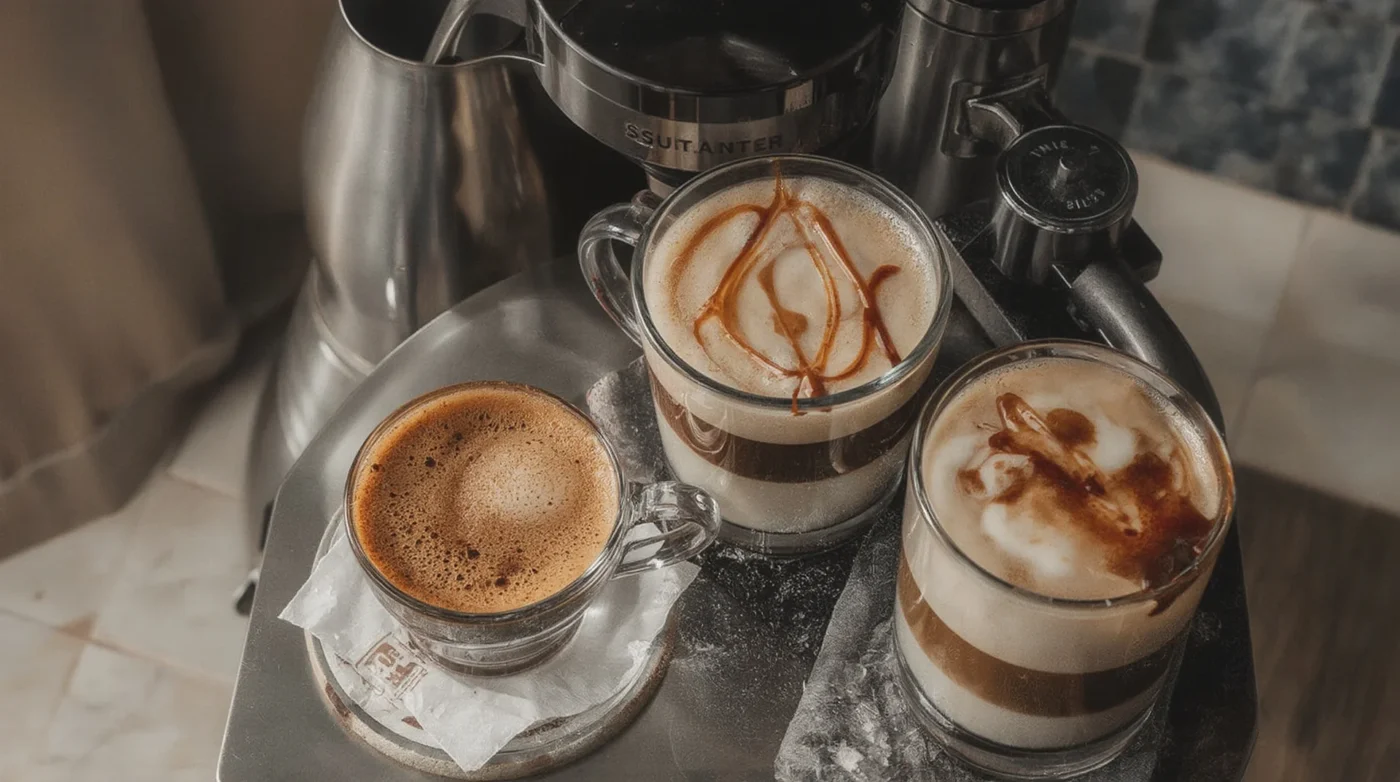How to Make a Macchiato: Tired of Watery Shots and Messy Milk Foam? You’re Not Alone.
Ever pulled a shot of espresso only to end up with bitter liquid or bubbly milk that refuses to foam just right? Or maybe you’ve followed a caramel macchiato recipe that left you with a sugar bomb and no coffee taste. You’re not the only one. Even seasoned home brewers wrestle with the nuances of the macchiato.
But here’s the good news: You can fix this today.
This guide is your hands-on coffee companion, expertly crafted to help you master every major macchiato variation, from the bold Espresso Macchiato to the layered Latte Macchiato and the Instagram-famous Iced Caramel Macchiato. We’ll walk you through not only the recipes but also the techniques, tools, and pro-level tips that take your brews from average to exceptional.
As a trained Q-Grader and passionate home barista, I’ve spent years refining these methods. And I’m here to guide you step by step.
By the end of this article, you’ll:
- Know exactly how to make a macchiato, no matter the style
- Understand espresso extraction, milk frothing, and drink layering
- Discover how to customize your macchiato to suit your taste and style
Ready to make every cup cafe-worthy? Let’s begin.
What Exactly is a Macchiato? Unveiling a Coffee Classic
Understanding the Name
“Macchiato” is Italian for “marked” or “stained.” Depending on the version, it refers to milk marked with espresso (Latte Macchiato) or espresso marked with milk foam (Espresso Macchiato).
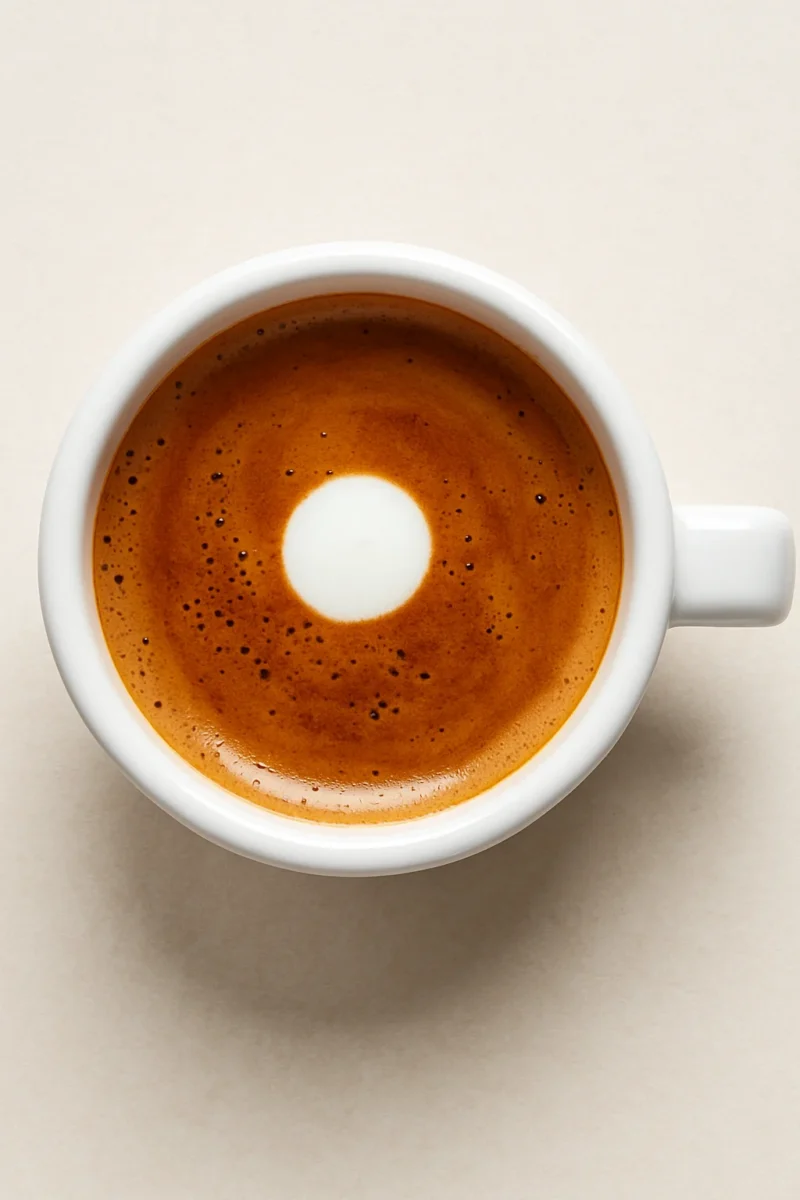
The Simplicity and Elegance
A macchiato celebrates espresso in its purest form, only slightly softened by milk. This minimalist approach emphasizes:
- The quality of ingredients
- The precision of the technique
- A balance of boldness and subtlety
Why It’s Gaining Popularity
From traditional espresso aficionados to those who love sweet café-style drinks, the macchiato appeals to all. Its versatility allows for both hot and iced preparations, as well as infinite customizations.
Explore the Evolution: From Italian espresso bars to global coffee chains like Starbucks, the macchiato has transformed, but its heart remains the same: espresso-first elegance.
Deciphering Macchiato Types: Traditional vs Latte Vs Caramel
Let’s explore how different macchiato styles uniquely express the combination of espresso and milk.
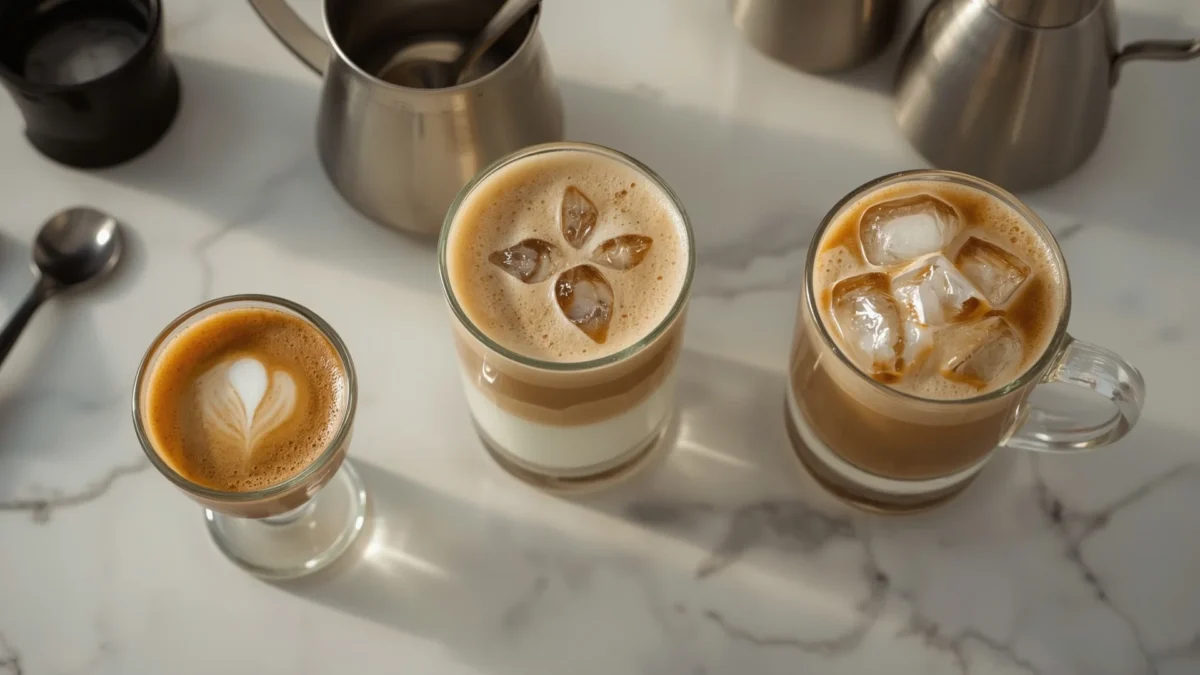
Espresso Macchiato
- What it is: A shot of espresso topped with a small dollop of foamed milk.
- Flavor: Intense and rich with subtle milk sweetness.
- Volume: ~2–3 oz.
- Serve: Demitasse cup
Latte Macchiato
- What it is: Steamed milk poured into a tall glass, “marked” with a shot of espresso.
- Flavor: Milk-forward with espresso floating mid-glass.
- Volume: 8–12 oz.
- Serve: Tall glass
Caramel Macchiato
- What it is: A Latte Macchiato sweetened with vanilla syrup and topped with caramel drizzle.
- Flavor: Sweet, creamy, lightly caffeinated.
- Volume: 8–16 oz.
- Serve: Tall glass (hot or iced)
Macchiato Types Comparison Chart
|
Feature |
Espresso Macchiato |
Latte Macchiato |
Caramel Macchiato |
|
Base |
Espresso |
Steamed Milk |
Steamed Milk |
|
Milk |
Dollop of foam |
Steamed + Foam |
Steamed + Foam |
|
Espresso Order |
Espresso first |
Milk first |
Milk first |
|
Volume |
2–3 oz. |
8–12 oz. |
8–16 oz. |
|
Key Flavor |
Bold espresso |
Mild espresso |
Sweet caramel, vanilla |
|
Serve |
Demitasse |
Tall glass |
Tall glass (hot/iced) |
Setting Up for Success: Ingredients & Equipment
Essential Ingredients
Coffee Beans:
- Go for freshly roasted, espresso-labeled whole beans.
- Medium-dark roast works best for rich crema and body.
Learn how to keep ground coffee fresh and preserve flavor.
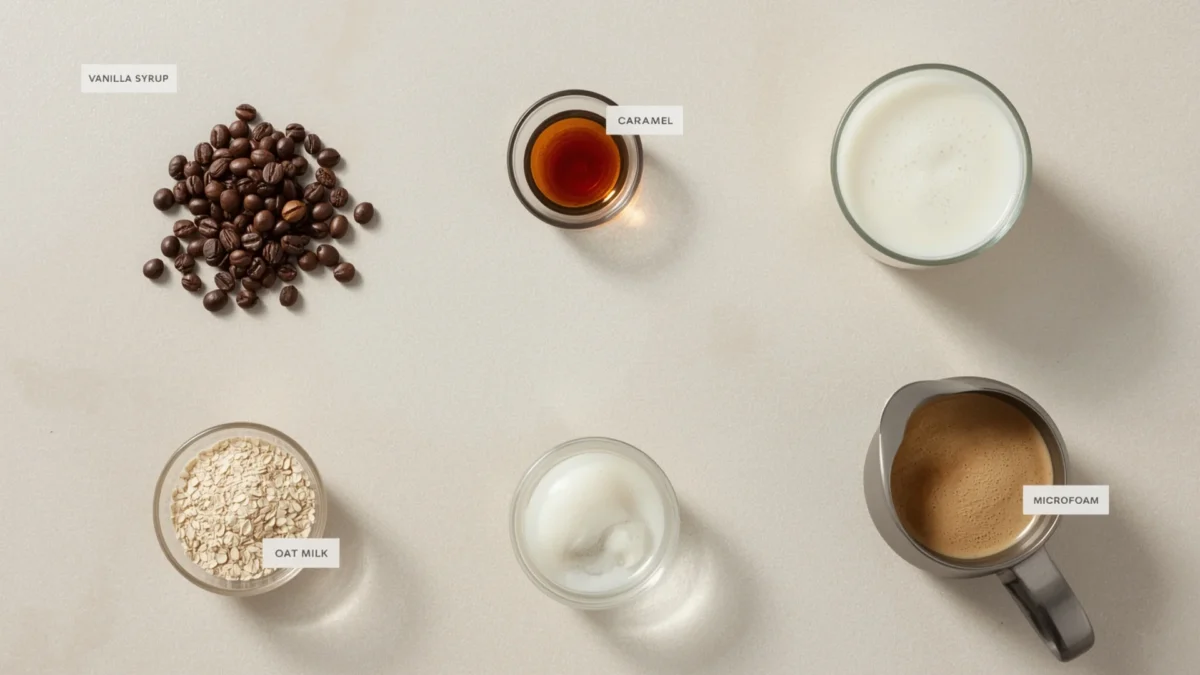
Milk Options:
- Dairy: Whole milk = best texture.
- Non-Dairy: Oat (best frother), almond, soy, coconut.
Discover where coffee beans originate and their varieties.
Explore the 4 different types of coffee beans.
Flavor Add-ons:
- Vanilla Syrup for caramel macchiato.
- Caramel Sauce for that Starbucks-style drizzle.
Pro Tip: Grind your beans right before brewing. The finer the grind (like table salt), the better the espresso extraction.
Check grind settings for Baratza Encore.
How to Make a Macchiato: Equipment, Choose Your Setup
Budget-Friendly (Entry-Level)
- Moka Pot or AeroPress
- Handheld frother or French press
- Regular mugs
Intermediate
- Entry-level espresso machine (De’Longhi Dedica, Gaggia Classic)
- Nespresso Aeroccino frother
- Tamper + Milk pitcher
Advanced (Barista-Grade)
- Breville Barista Express
- Burr grinder for consistent espresso grind
- Precision tamper, digital scale, milk thermometer
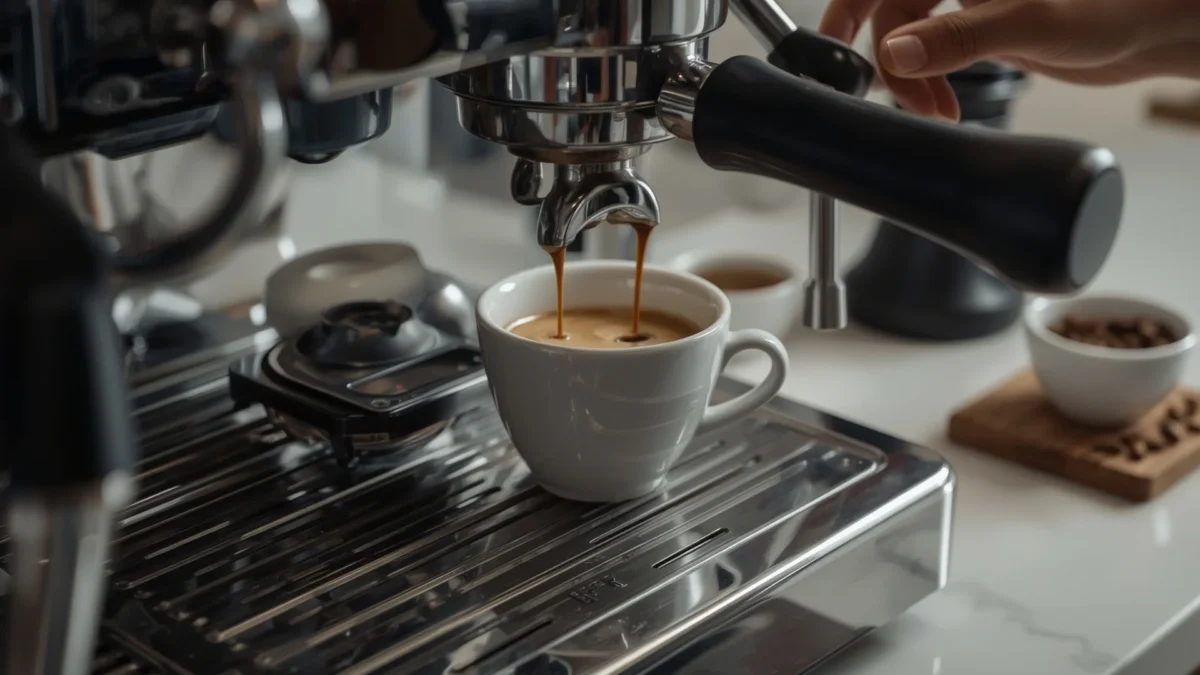
Must-Have Tools Recap:
- Espresso machine or Moka pot
- Burr grinder
- Milk frother
- Thermometer (140–155°F is sweet spot)
- Serving cups: Demitasse + tall glass
Learn more about coffee brewing ratios and how much coffee to pour over.
Unlock the best way to prepare coffee at home.
Crafting the Hot Macchiato: Espresso Macchiato & Latte Macchiato
Mastering how to make a macchiato starts with understanding your base, espresso. Whether you’re making a bold Espresso Macchiato or a silky Latte Macchiato, precision is key.
The Foundation: Perfecting Your Espresso Shot
Great macchiatos begin with great espresso.
Step-by-Step Guide to Pulling the Perfect Espresso Shot
- Grind Your Beans Fresh: Use a fine espresso grind, like table salt. Burr grinders are best.
- Dose Accurately: 18–20g for a double shot (use a digital scale).
- Tamp Evenly: Apply firm, even pressure using a flat tamper.
- Lock and Brew: Insert the portafilter and start brewing.
- Extract: Aim for 25–30 seconds and a 1:2 ratio of coffee grounds to liquid.
Expert Tip: Always pre-warm your cup. This stabilizes espresso temperature and enhances crema.
Making an Espresso Macchiato (Traditional)
Now that your espresso’s ready, it’s time to master how to make a macchiato in its original form.
Espresso Macchiato Steps:
- Step 1: Pull a fresh single or double espresso shot into a demitasse.
- Step 2: Steam a small amount of milk (~2–3 oz.) to create microfoam, thick, velvety foam with no big bubbles.
- Step 3: Use a spoon to gently place 1–2 teaspoons of foam onto the center of the espresso.
- Step 4: Serve immediately.
Making a Latte Macchiato
Ready to reverse the process? Here’s how to make a latte macchiato, a drink that highlights milk over espresso.
Latte Macchiato Steps:
- Step 1: Steam 6–8 oz. of milk to a silky, microfoamed texture.
- Step 2: Pour steamed milk into a tall glass. Let the foam settle on top.
- Step 3: Slowly pour a fresh espresso shot through the milk foam. This will create a distinct middle espresso layer.
- Step 4: Serve immediately.
Pro Insight: The slower you pour the espresso, the cleaner the layers will be.
Mastering the Iced Macchiato (Caramel Macchiato)
Many people asking how to make a macchiato are really asking about one thing: that gorgeous, layered, sweet iced caramel macchiato. Let’s break it down.
The Iced Caramel Macchiato Breakdown
Ingredients:
- Ice cubes
- Milk (whole or oat for best texture)
- Vanilla syrup (1–2 pumps, to taste)
- Freshly pulled espresso shot
- Caramel sauce for drizzle
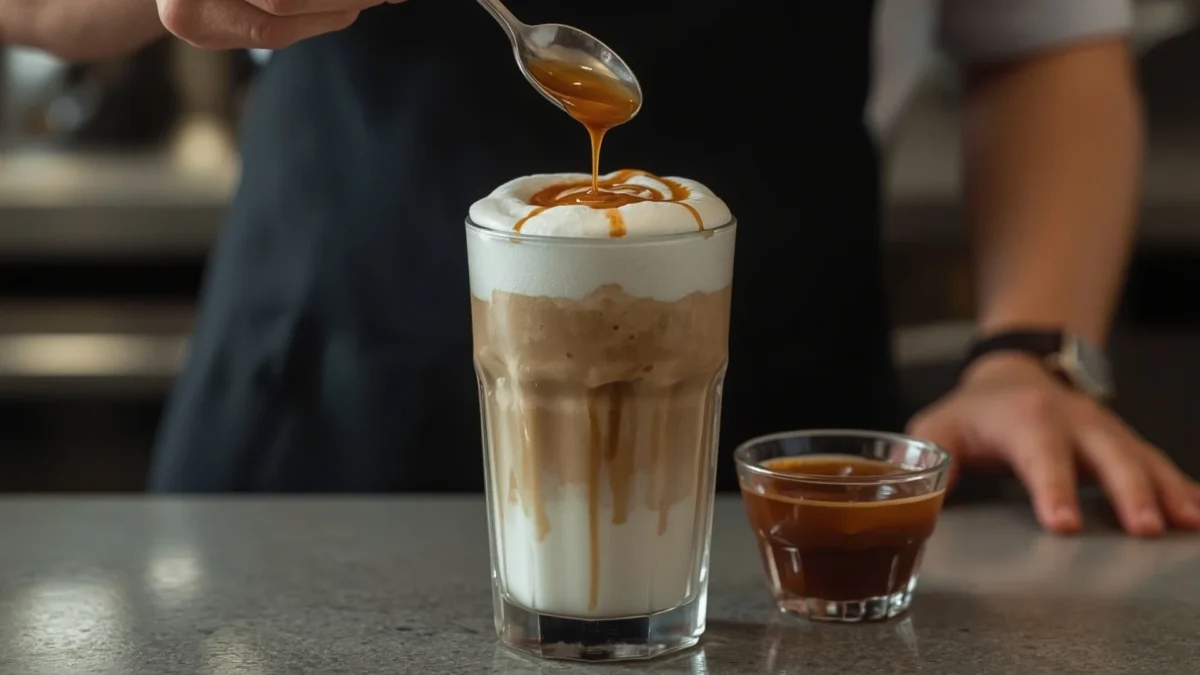
Step-by-Step Iced Caramel Macchiato
Step-by-Step:
- Fill a tall glass with ice cubes.
- Add vanilla syrup directly to the glass.
- Pour cold milk (~¾ of the glass).
- Pull a fresh espresso shot and slowly pour over the milk and ice.
- Drizzle caramel sauce down the inside of the glass and across the foam layer.
Serve with a straw and enjoy the beautiful layers before your first sip.
Expert Note from Atika:
“Layering is science! Hot espresso is less dense than cold milk. If you pour slowly, the espresso floats. That’s what makes an iced caramel macchiato visually stunning.”
The Art & Science of Milk Frothing Masterclass
Understanding Microfoam: The Holy Grail of Steamed Milk
Microfoam is the velvety, silky-smooth milk used in nearly every professional espresso drink. In a macchiato, it serves two purposes:
- Adds creamy texture
- Creates visual appeal (especially in layered drinks)
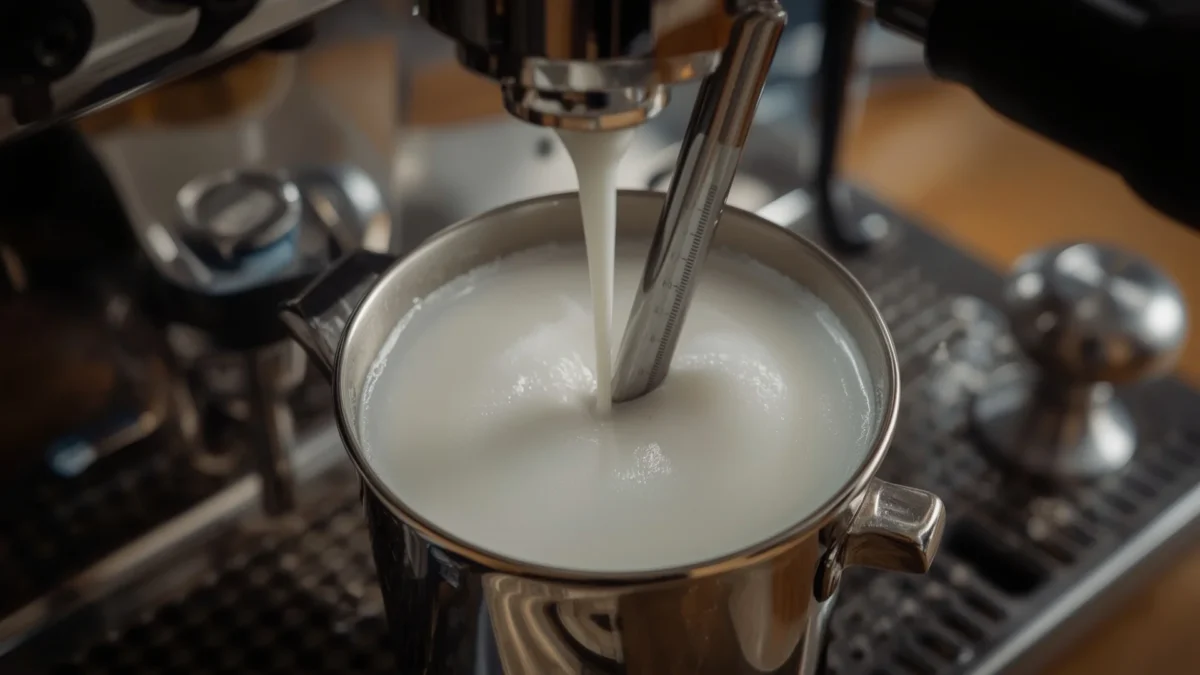
What Makes Microfoam Different?
- No big bubbles
- Glossy sheen
- Soft, pourable texture that integrates with the liquid
Tip: According to the Speciality Coffee Association (SCA), ideal steamed milk should be between 140–155°F (60–68°C) and possess a smooth, glossy texture, rather than a bubbly one.
Frothing Methods Explained
Whether you’re just starting or building a barista-grade setup, here’s how to create perfect froth for any style of macchiato.
Steam Wand (Espresso Machine)
The gold standard for microfoam.
Steps:
- Purge the steam wand to remove residual water.
- Submerge the wand just below the surface of the milk.
- Start stretching (incorporate air), listen for a gentle “tss tss.”
- Angle the jug and position the wand to create a whirlpool for texturing.
- Heat until 140–150°F, then stop and swirl to polish.
Best for: Latte Macchiato, Caramel Macchiato
Handheld Electric Frother
Great for quick foam, especially for an Espresso Macchiato.
How-To:
- Heat milk separately.
- Froth in short pulses, then swirl.
Pros: Affordable, portable
Cons: Can’t achieve true microfoam
French Press Method
Manual frothing by plunging hot milk.
Steps:
- Heat milk (don’t boil).
- Pour into the French press.
- Plunge up and down vigorously until foam forms.
Tip: Best for whole milk or oat milk.
Automatic Milk Frothers
For consistent results without a technique.
Example: Nespresso Aeroccino
Pros: Set-and-forget
Cons: Less control, may overheat milk
Troubleshooting Milk Foam
Common Problems & Fixes:
|
Problem |
Cause |
Solution |
|
Foam is too bubbly (dish soap-like) |
Too much air, wand too high |
Lower your wand slightly; stretch for only the first few seconds |
|
Foam too flat |
Not enough air or wand too deep |
Raise the wand closer to the surface during the initial stretch phase |
|
Milk tastes burnt |
Overheated (above 160°F) |
Stop at 140–155°F and use a thermometer |
|
Foam collapses quickly |
Low-fat milk or improper texture |
Use whole milk or adjust the frothing technique |
Expert Tip:
Clean your wand or frothing tool immediately after use. Milk residue hardens fast and affects hygiene and performance.
Now that you’ve mastered frothing, let’s troubleshoot the most common problems people encounter when learning how to make a macchiato at home.
Troubleshooting Common Macchiato Problems
Espresso Issues
Problem: Weak or Watery Espresso
Cause:
- The grind is too coarse
- The coffee dose is too low
- Extraction time is too short
Fix:
- Adjust the grind to a finer setting
- Use a digital scale to dose 18–20g (double shot)
- Aim for a 25–30 second extraction
Problem: Bitter or Burnt Espresso
Cause:
- Over-extracted shot (brewing took too long)
- Water temperature is too high
- Grind too fine
Fix:
- Grind slightly coarser
- Check water temp (ideal is 195–205°F or 90–96°C)
- Ensure your espresso pull stays within 30 seconds
Pro Tip:
Espresso that extracts too fast = sour. Too slow = bitter. Use a timer for consistency.
Pain Point: Cafe-Quality Shots Are Hard to Replicate at Home
Solution: Invest in a burr grinder, use filtered water, and measure dose and yield with a scale. It’s the small details that level up your brew.
Milk Frothing Woes
Problem: Foam Looks Like Dish Soap (Big Bubbles)
Cause: Wand too high, added air too fast
Fix: Lower the wand slightly and stretch only for the first 3–5 seconds
Problem: Flat Foam (Just Hot Milk)
Cause: The Wand was submerged too deeply, and no air was incorporated
Fix: Raise the wand to the milk’s surface to allow air entry at the start
Problem: Milk Not Sweet or Tastes Burnt
Cause: Overheating
Fix: Stop steaming at 140–155°F for perfect sweetness and mouthfeel
Scientific Note: Lactose caramelizes at around 155°F, contributing to the natural sweetness of steamed milk. Go beyond that, and the milk tastes scorched.
Layering Challenges (Iced Macchiato)
Problem: No Layer Separation
Cause: Poured espresso too fast or didn’t control the flow
Fix: Pour espresso slowly over a spoon resting on the ice or milk to control the descent. Use cold milk and plenty of ice to enhance density separation.
Pain Point: Iced Caramel Macchiato Doesn’t Look “Instagrammable”
Solution:
- Use a clear, tall glass
- Pour slowly
- Add caramel drizzle last for aesthetic flair
Inconsistency in Homemade Macchiato
Consistency is the holy grail of coffee brewing. And most at-home inconsistencies come down to three things:
- No scale = eyeballing doses
- No thermometer = overheating milk
- Infrequent cleaning = residue affecting flavor
Fix:
- Use a digital scale for every shot
- Steam milk with a milk thermometer
- Clean equipment after every session
Atika’s Advice: “The best home baristas aren’t the ones with the most expensive machines, they’re the ones who measure, clean, and practice.”
Elevating Your Macchiato: Customization & Beyond
Flavor Customization
Your macchiato can be as simple or as adventurous as you like.
Popular Add-ins:
- Syrups: Vanilla, hazelnut, peppermint, cinnamon dolce
- Drizzles: Caramel (classic), chocolate, white chocolate
- Powders: Cocoa, cinnamon, nutmeg on top of the foam
Tip: Add syrup to milk before layering to keep sweetness balanced.
Milk Alternatives & Their Impact
Not all milk froths the same. If you’re exploring how to make a macchiato with plant-based milk, here’s what to expect:
|
Milk Type |
Frothing Ability |
Flavor Profile |
|
Whole Milk |
Excellent |
Rich, creamy |
|
Oat Milk |
Very Good |
Naturally sweet, full-bodied |
|
Almond Milk |
Moderate |
Nutty, light |
|
Soy Milk |
Good |
Creamy, slightly beany |
|
Coconut Milk |
Poor |
Thin, tropical |
Best Frothing Non-Dairy: Oat milk
Macchiato Flavor Pairing Guide
Why stop at the drink? Pair your perfect macchiato with a treat to elevate the experience.
|
Macchiato Type |
Great With |
|
Espresso Macchiato |
Dark chocolate, biscotti |
|
Latte Macchiato |
Croissant, lemon tart |
|
Caramel Macchiato |
Brownie, shortbread cookies |
Unique Flavor Additions:
- A dash of orange zest in espresso for a citrusy punch
- Infused syrups like lavender or rosemary for floral notes
Pro Tip: Try cardamom or cinnamon in your espresso puck for subtle spice infusion.
Advanced Techniques & Presentation
Want to take your macchiato to the next level? Try these enhancements.
Basic Latte Art
- Use microfoam to create hearts, rosettes, or even a simple dot on an Espresso Macchiato.
Garnish Ideas
- Shaved chocolate
- Crushed pistachios
- Edible flower petals
Conclusion & Enjoyment
Let’s recap your journey through the world of macchiatos.
Key Takeaways:
- A macchiato is all about balance—whether bold and minimalist (Espresso Macchiato) or sweet and layered (Caramel Macchiato).
- Great drinks come from quality beans, precise espresso, and mastered milk frothing.
- Customization is where your creativity shines. Flavor it, layer it, pair it!
Encouragement:
Don’t get discouraged by a frothing flop or an uneven layer. Barista-level results come with practice, and every attempt brings you closer.
Remember: Knowing how to make a macchiato is not just a skill, it’s an art.
- Share your creations on Instagram and tag us @RustCoffee
- Have questions? Drop them in the comments below.
- Want the checklist PDF? Sign up to get our “Macchiato Masterclass” printable sent to your inbox.
Now you’re not just a coffee drinker, you’re a macchiato maker.
And if anyone ever asks how to make a macchiato, you’ll know exactly what to say (and serve).

